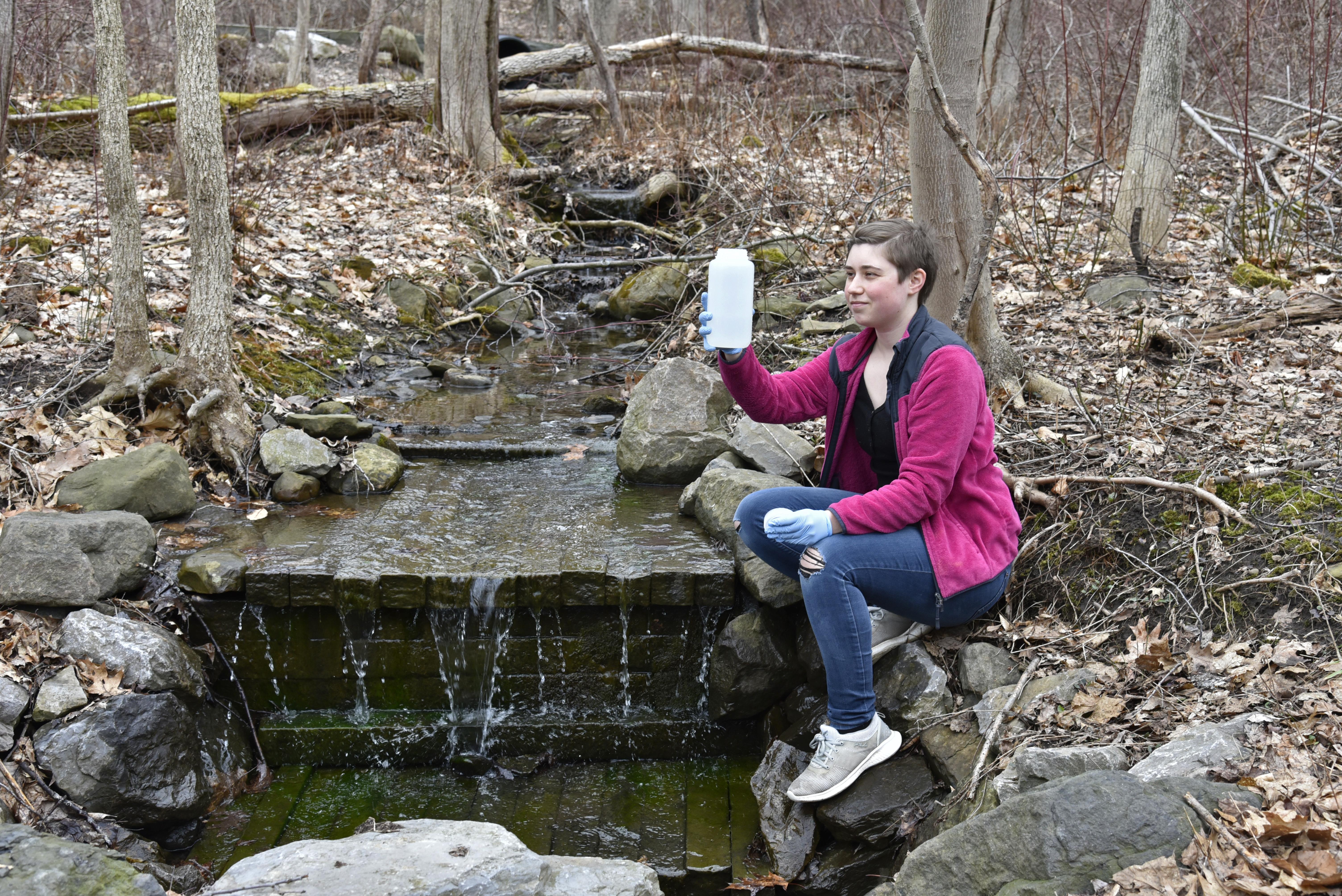SUNY Oswego senior zoology major Jamie Perrin collects environmental DNA (eDNA) from recent winter melt in Oswego for her research project funded by a Student Scholarly and Creative Activity Grant.
SUNY Oswego senior zoology major Jamie Perrin recently earned a Student Scholarly and Creative Activity Grant for research she hopes will provide a better understanding of the movement, degradation rate and impact of the weather on the local bird population by performing eDNA (environmental DNA) collection and research.
Perrin’s research, titled “Estimating the Detection Rate of the Strix Varia Over the Course of a Spring Snowmelt Event,” focuses on the barred owl, found throughout the eastern United States and the Pacific Northwest. Generally found in trees and near bodies of water, they provide a great subject for Perrin’s study.
Perrin is first creating a primer for her species-specific study which will allow her to focus on barred owl eDNA. Perrin will then use a PCR (polymerase chain reaction) to see if there is any barred owl eDNA present within the water sample.
“My goal is to see how eDNA concentration might change over the course of a melt event,” said Perrin, who hails from Stanley in Ontario County. “This involves taking several baseline samples, as well as once it begins to warm up. I will take several more frequent samples and then analyze eDNA concentration using nanodrop as well as determine when my species of interest is detected within the samples.”
As Perrin collects eDNA from samples throughout the melt period, the goal is to determine at which point through the spring melt holds the greatest amount of barred owl eDNA for species detection.
“The idea here is that the amount of eDNA concentration and our ability to pick up eDNA from a species of interest may change as a result of weather conditions,” Perrin said. “My goal is to determine at which point throughout a melt event might one be most likely to pick up the greatest amount of target eDNA. A melt event will be taking snow and any eDNA it has been collecting as well as bringing dirt and other contaminants into the water system that I will be sampling from.”
Controlled lab experiments
Perrin’s research takes place within a controlled environment to provide stable eDNA sampling and standardized testing, and to ensure the accuracy of her eDNA collection.
“Understanding the rate of eDNA degradation will aid in the analysis of species presence and sampling will provide invaluable information for how long eDNA might remain in the environment before breaking down and being undetectable and leading to potential false negatives within samples.” Perrin said. “If a species is present within an area, but the eDNA breaks down too much before sampling, it may appear in the samples as though the species is not in the area.”
Perrin hopes that her research will not only help future researchers but also future species monitoring and tracking. Perrin believes her research “specifically will provide insight into eDNA degradation as well as how weather patterns such as a melt event will impact the transport and presence of eDNA.”
Perrin has been mentored by assistant professor Nicholas Sard in the biological sciences department. They have met weekly to review Perrin’s progress, review the week ahead, and also meet with other student researchers to discuss their projects and read papers together.
Student Scholarly and Creative Activity Grant
Other funded fall 2021 Student Scholarly and Creative Activity grants included:
- “Concurrent Symbolic Integration” by Dominic Altamura, with faculty mentor Ioana Coman, computer science;
- “Using Automated Recording Units to Study Northern Cardinal Vocal Behavior" by Brooke Goodman, with faculty mentor Daniel Baldassarre, biological sciences;
- “The Costs and Benefits of the ‘Hyper Brain’: How Intelligence, Anxiety, Overthinking and Rumination Interact” by Quinn Ceilly, with faculty mentor Leigh F. Bacher, psychology;
- "Boys Can Wear Pink, Too!” by Justin Fischnich with faculty mentor Ritu Radhakrishnan, curriculum and instruction
For more information on these and other funding opportunities to support scholarly and creative activities, visit the Internal Grants website for Office of Research and Sponsored Program.




